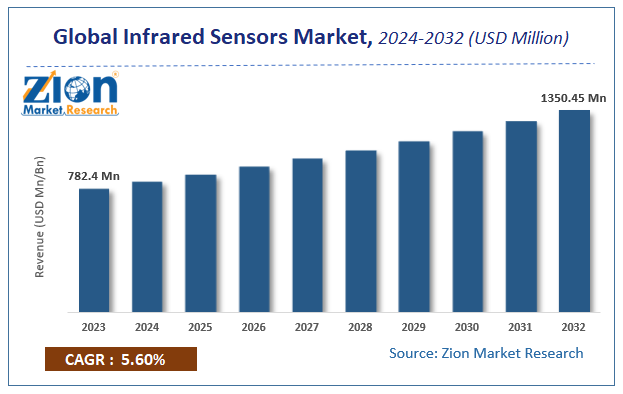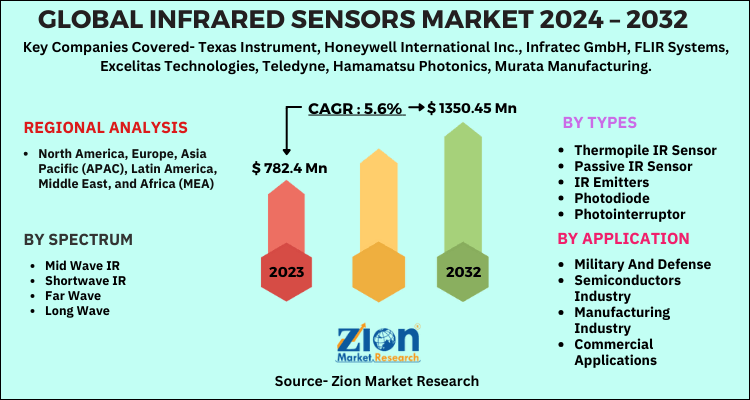Infrared Sensors Market Size, Share, Trends, Growth and Forecast 2032

Infrared Sensors Market - by Spectrum (Mid Wave IR (MWIR), Shortwave IR (SWIR), Far Wave (FWIR), Long Wave (LWIR)), by Types (Thermopile IR Sensor, Passive IR Sensor, IR Emitters (LEDs), Photodiode, Photointerruptor, IR Receivers, Tilt Sensor, Photo Reflector, Communication Modules (IrDA), IR Linear Arrays), by Application (Military And Defense, Semiconductors Industry, Manufacturing Industry, Commercial Applications, Telecommunications Sector), and by Region: Global Industry Perspective, Comprehensive Analysis and Forecast 2024 - 2032-
| Market Size in 2023 | Market Forecast in 2032 | CAGR (in %) | Base Year |
|---|---|---|---|
| USD 782.4 Million | USD 1350.45 Million | 5.6% | 2023 |
Infrared Sensors Market Insights
According to Zion Market Research, the global Infrared Sensors Market was worth USD 782.4 Million in 2023. The market is forecast to reach USD 1350.45 Million by 2032, growing at a compound annual growth rate (CAGR) of 5.6% during the forecast period 2024-2032.
The report offers a comprehensive analysis of the market, highlighting the factors that will determine growth, potential challenges, and opportunities that could emerge in the Infrared Sensors industry over the next decade.
The Infrared Sensor market is anticipated to register growth owing to tremendous demand for IoT technology. IoT technology and Artificial Intelligence in conjunction is driving the demand for automation in industry landscape which in turn increasing the demand for Infrared Sensor.
Global Infrared Sensors Market: Overview
Infrared sensors are basically electronic components that radiate the radiation and perceive light signals into the infrared array. These are categorized into two major categories specifically detectors and infrared sensors. Infrared detectors are actually the microchips majorly utilized for infrared light recognition.
Global Infrared Sensors Market: Growth Factors
The momentous growth in security issues among customers and the rising demand and popularity for customer electronics equipment/products is impacting the global infrared sensors market to a great extent. The huge demand for safety particularly at commercial places, for instance, hospitals; offices; and hotels are expected to fuel the expansion of this market upward in the years to come.
Along with this, the turn down in the retail cost of these particular sensors is also anticipated to fuel the demand and popularity for the global infrared sensors market outstandingly, in the coming years. The growing development of automation all over the end-user industries, for instance, aerospace and defense, semiconductor & electronics, healthcare and medical sectors is another significant feature that is projected to fuel the expansion of the global infrared sensor market, worldwide, in the future. The market, on the other hand, can be restricted in the coming future due to high manufacturing expenditure and strict government policies.
Global Infrared Sensors Market: Segmentation
The global infrared sensors market is classified based on different parameters. The global infrared sensors market is divided in terms of the spectrum which is further sub-divided into Mid Wave IR (MWIR), Shortwave IR (SWIR), Far Wave (FWIR) and Long Wave (LWIR). Based on types, the global infrared sensors are categorized into Thermopile IR Sensor, Passive IR Sensor, IR Emitters (LEDs), Photodiode, photointerruptor, IR Receivers, Tilt Sensor, Photo Reflector, Communication Modules (IrDA) and IR Linear Arrays. In terms of applications, the market is categorized into military and defense, semiconductors industry, manufacturing industry, commercial applications, and telecommunications sector.
Infrared Sensors Market: Report Scope
| Report Attributes | Report Details |
|---|---|
| Report Name | Infrared Sensors Market |
| Market Size in 2023 | USD 782.4 Million |
| Market Forecast in 2032 | USD 1350.45 Million |
| Growth Rate | CAGR of 5.6% |
| Number of Pages | 110 |
| Key Companies Covered | Texas Instrument, Honeywell International Inc., Infratec GmbH, FLIR Systems, Excelitas Technologies, Teledyne, Hamamatsu Photonics, Murata Manufacturing, Nippon Avionics and Raytheon, are among others |
| Segments Covered | By Types, By Applications And By Region |
| Regions Covered | North America, Europe, Asia Pacific (APAC), Latin America, Middle East, and Africa (MEA) |
| Base Year | 2023 |
| Historical Year | 2018 to 2022 |
| Forecast Year | 2024 - 2032 |
| Customization Scope | Avail customized purchase options to meet your exact research needs. Request For Customization |
Global Infrared Sensors Market: Regional Analysis
Europe and North America have come up as the most important market for infrared sensors, and are expected to grow at a considerable share in terms of revenue in the coming years. North America, is likely to be followed by Europe, due to the greater utilization of infrared sensors, as compared to other regions. The increasing consumption of infrared sensors particularly in identifying motion that supports in recognizing the aim from a far place is projected to fuel the North America infrared sensors market, in the coming future. The infrared sensors market in Europe is predicted to be largely boosted by the increasing demand and popularity of infrared sensors.
The huge demand for the rising usage of infrared sensors and motion sensing in drones and unmanned aerial vehicles are likely to fuel the market considerably in Europe. The constant research & development activities, growing demand and popularity for automation in the construction and the industrial division, and the rising penetration rate for customer electronics, such as laptops, tablets, and smartphone, are also likely to fuel the global infrared sensors market in the Asia Pacific.
Global Infrared Sensors Market: Competitive Players
Some of the most important market players in the global infrared market are-
- Texas Instrument
- Honeywell International Inc.
- Infratec GmbH
- FLIR Systems
- Excelitas Technologies
- Teledyne
- Hamamatsu Photonics
- Murata Manufacturing
- Nippon Avionics and Raytheon
- are among others.
Global Infrared Sensors Market: Regional Segment Analysis
- North America
- The U.S.
- Europe
- The UK
- France
- Germany
- The Asia Pacific
- China
- Japan
- India
- Latin America
- Brazil
- The Middle East and Africa
What Reports Provides
- Full in-depth analysis of the parent market
- Important changes in market dynamics
- Segmentation details of the market
- Former, on-going, and projected market analysis in terms of volume and value
- Assessment of niche industry developments
- Market share analysis
- Key strategies of major players
- Emerging segments and regional markets
- Testimonials to companies in order to fortify their foothold in the market.
Table Of Content
Methodology
FrequentlyAsked Questions
global Infrared Sensors Market was worth USD 782.4 Million in 2023. The market is forecast to reach USD 1350.45 Million by 2032,
growing at a compound annual growth rate (CAGR) of 5.6% during the forecast period 2024-2032.
The largest share of the Infrared Sensors Market is held by Asia Pacific. Developing countries of Asia Pacific such as China, Japan, and India will be dominating the market scenario mainly due to the rising constructional activities. The growth of Asia-Pacific region is expected to be followed by the Middle East and North America. Also, significant growth is expected from Western Europe owing to the developments taking place in this region especially in countries such as Italy, Germany, the U.K, France, and Spain. However, growth in Africa, Latin America, and Eastern Europe is anticipated to be moderate over the forecast period.
Texas Instrument, Honeywell International Inc., Infratec GmbH, FLIR Systems, Excelitas Technologies, Teledyne, Hamamatsu Photonics, Murata Manufacturing, Nippon Avionics and Raytheon, are among others
HappyClients
Zion Market Research
Tel: +1 (302) 444-0166
USA/Canada Toll Free No.+1 (855) 465-4651
3rd Floor,
Mrunal Paradise, Opp Maharaja Hotel,
Pimple Gurav, Pune 411061,
Maharashtra, India
Phone No +91 7768 006 007, +91 7768 006 008
US OFFICE NO +1 (302) 444-0166
US/CAN TOLL FREE +1 (855) 465-4651
Email: sales@zionmarketresearch.com
We have secured system to process your transaction.
Our support available to help you 24 hours a day, five days a week.
Monday - Friday: 9AM - 6PM
Saturday - Sunday: Closed






